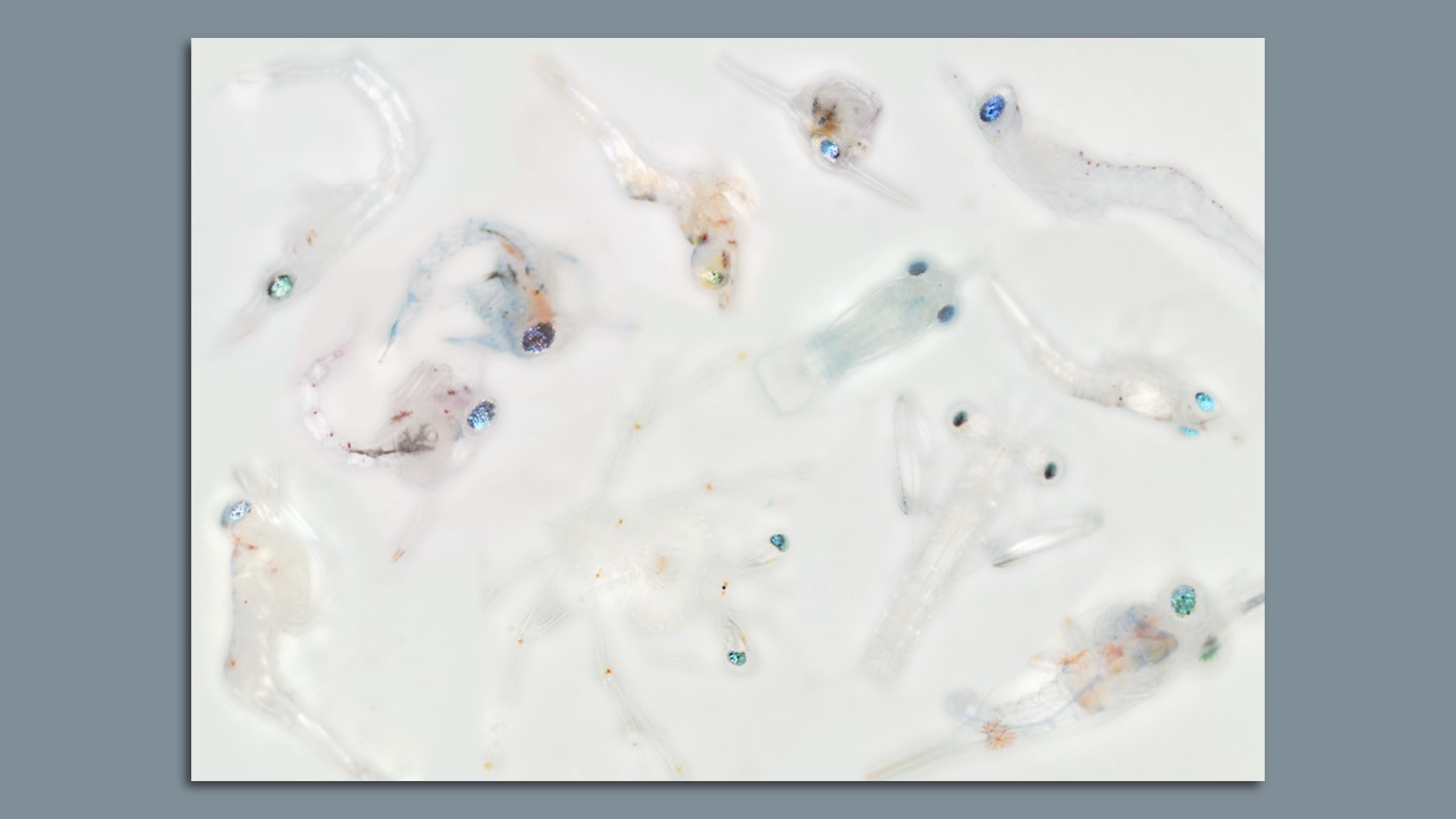| | | | | | | Presented By Babbel | | | | Axios Science | | By Alison Snyder · Feb 16, 2023 | | Thanks for reading Axios Science. This week's newsletter is 1,629 words, about a 6-minute read. 1 big thing: Axios is hosting our second annual What's Next Summit on March 29 in Washington, D.C. Check out our speaker lineup and register to livestream the event here. Programming note: We'll be off next week and back in your inbox on March 2. | | | | | | 1 big thing: Quantum eyes in the skies |  | | | Illustration: Aïda Amer/Axios | | | | Quantum sensing devices that can gather ultra-precise data are being readied to test in the sky — and could define warfare and intelligence gathering in the 21st century. Why it matters: Quantum computing usually gets the attention — and most of the funding — but quantum sensors are advancing quickly and are expected to be deployed sooner. - Quantum sensors can measure minute changes in the environment and could one day be used to detect objects underwater or underground, or to provide navigational information if GPS is knocked out or not available.
- They could also play a key role in creating practical quantum computing.
How it works: Like quantum computers, quantum sensors are built on quantum bits, or qubits. - Qubits can be manufactured or naturally occurring photons, ions and neutral atoms.
- Unlike quantum computers that, at useful scales, will require hundreds of thousands of precisely controlled qubits protected from the environment, quantum sensors take advantage of the fragility of those quantum states to extract information from the environment.
- They generally use two properties of quantum mechanics — superposition and entanglement — to measure changes in rotation, pressure, gravity and magnetic or electric fields.
- Atomic clocks used for GPS are quantum-sensing timekeepers and magnetic resonance imaging (MRI) measures changes in the quantum mechanical properties of hydrogen atoms to create medical images.
What's happening: Quantum sensors are being developed for a range of applications from smart building monitoring and oil prospecting to intelligence gathering and navigation. These devices, which are in general more precise than their classical counterparts, include next generation atomic clocks as well as: - Quantum gravimeters: When mass decreases, so does gravity — an often subtle change that these devices can measure. They could be used to discover underground tunnels or water, new oil fields or precious metals that have different densities. They can measure these changes at the level of a centimeter and are "very, very sensitive," says Michal Krelina, a quantum security consultant at EU Agency for the Space Programme (EUSPA), but they aren't good for spotting something small, he adds.
- Quantum inertial navigation: Quantum-based measurements of acceleration, rotation and time could provide extremely accurate positioning information that doesn't drift like existing classical devices. It might allow nuclear submarines to remain underwater rather than surface every few days to sync with GPS.
- Quantum radio frequency sensors: Leveraging quantum properties, these devices aim to use one receiver tuned to many frequencies across the spectrum. That would allow multiple receivers to be packed into a device smaller than the 6-foot-tall antenna on top of cell towers today, says Bob Sutor of quantum technology startup Infleqtion, which is developing quantum RF antennas.
Where it stands: Some of these technologies, like navigation systems, may be ready in two to five years, Krelina predicts, whereas others may be 10 years out. - The U.S. Air Force recently awarded SandboxAQ a contract to develop its quantum navigation technology that the company says would act as a complement to GPS. The plan is to demonstrate the technology on U.S. Air Force aircraft.
- Other companies — including Rafael Advanced Defense Systems in Israel and Q-CTRL in Australia — as well as NATO, the U.S., China and other militaries are developing quantum sensing devices.
The intrigue: Quantum sensors can be tested on satellites, drones and aircraft. - But stratospheric balloons offer advantages: "They have amazing line of sight. It's really cheap to launch it alone, versus sending a satellite or plane up," Sutor says. And, "it's very gentle."
- Infleqtion and WorldView, which uses balloons to study Earth's stratosphere, recently announced a partnership to test quantum sensing technology on the platform.
Read the entire story. |     | | | | | | 2. Thwaites Glacier findings reveal clues about Antarctic ice melt |  | | | Icefin under the sea ice near McMurdo Station captured in 2019. Photo: Rob Robbins, USAP Diver | | | | New studies found Thwaites Glacier, the largest glacier in West Antarctica, is melting faster in some spots than its shape would at first suggest, Axios' Andrew Freedman reports. Why it matters: Thwaites tops the list of glaciers that keep polar scientists up at night. If it were to disintegrate into the ocean, the portions of the West Antarctic Ice Sheet it holds back could raise global sea levels by up to 10 feet. Driving the news: Two new studies published yesterday in the journal Nature provide some of the most detailed results gleaned from a $50 million, five-year international research campaign between the U.S. and the U.K., aimed at shedding light on the factors influencing Thwaites' future. - Specifically, scientists were interested in investigating the glacier's grounding zone, which is where the ice meets the sea and becomes a floating ice shelf.
State of play: Thwaites is unique in that as one travels inland from the grounding line, the ice rests on bedrock that dips below sea level. - This makes this region especially susceptible to extensive and potentially rapid melting since there is no hill or steep upward slope to slow or stop the ice's retreat.
How they did it: Scientists used remotely operated submersibles, including a craft known as Icefin, inserted into a 2,000-foot hole drilled into the ice, along with other means to obtain data on the water coming into contact with Thwaites' grounding line and floating ice shelf. - The submersible captured data on ocean temperatures and salinity, among other important variables.
- Abundant new information was also gleaned about the topography of the bedrock underlying the glacier, including at the grounding line.
Of note: Thwaites may have already begun a rapid and irreversible ice loss that will add about 2 feet of sea level rise this century. Between the lines: One of the studies found that water that is well above freezing is located near the grounding zone, but not all of it is reaching the base of the ice. - This suggests that rapid grounding line retreat, which continues to be observed here, could be tied to modest melt rates, and that this pace of retreat is likely to continue.
- Should the even warmer water reach the base of the ice, retreat would likely quicken, and it may be much higher in other parts of the glacier this study did not examine.
- "The [melt] rates found at the particular location were low and yet this is a place that retreated fast," study coauthor Eric Rignot of UC Irvine told Axios via email.
- "This means we should be worried, very worried for the other places where the melt [rates are] high and the retreat is high. The system is very sensitive to the ocean, more than we thought."
Read the entire story. |     | | | | | | 3. An infant galaxy like our own |  | | | Artist's illustration of The Sparkler. Image: James Josephides, Swinburne University | | | | Scientists using the James Webb Space Telescope have found a galaxy that may look like a young version of our Milky Way, Axios' Miriam Kramer writes. Why it matters: By studying this galaxy and its potential growth, researchers may be able to learn more about our own galaxy and its early evolution. What they found: The galaxy, called The Sparkler, appears to be surrounded by satellite galaxies and globular clusters, according to the study published in Monthly Notices of the Royal Astronomical Society. - As the galaxy grows, it swallows those objects surrounding it, giving it the potential to grow into a galaxy like our own, the study suggests. The Milky Way is home to about 200 globular clusters.
- "We appear to be witnessing, first hand, the assembly of this galaxy as it builds up its mass — in the form of a dwarf galaxy and several globular clusters," Duncan Forbes, one of the authors of the study, said in a statement.
- "We are excited by this unique opportunity to study both the formation of globular clusters, and an infant Milky Way, at a time when the universe was only one-third of its present age."
How it works: The Sparkler was seen by JWST as it looked through space and back 9 billion years, thanks to a lucky alignment of a dense cluster of galaxies that bent and magnified the light emitted by the more distant galaxy, allowing it to be seen. |     | | | | | | A message from Babbel | | Don't just see the world — stop and say "Olá" or "Hola" | | |  | | | | 'Tis the season to learn Spanish or Portuguese with Babbel, a platform built by more than 150 expert linguists. With daily 10-minute lessons, including videos and live classes with top teachers, you'll be able to hold actual conversations in as little as 3 weeks. Get up to 55% off for a limited time. | | | | | | 4. Worthy of your time |  | | | Illustration: Natalie Peeples/Axios | | | | ChatGPT's edge: We want to believe (Scott Rosenberg — Axios) Psychedelics may improve mental health by getting inside nerve cells (McKenzie Prillaman — Science News) Unplugging asthmatic airways (Patience Asanga — Knowable) Paleotsunami detectives hunt for ancient disasters (Nathaniel Scharping — Hakai) |     | | | | | | 5. Something wondrous |  | | | Optical microscope images of larval crustaceans. Image: Keshet Shavit/Ben-Gurion University of the Negev | | | | Young crustaceans have light reflectors made of tiny crystals that cover their dark eyes and complete the transparent creatures' camouflage in the sea, scientists report today. Why it matters: The light-manipulating "eyeglitter" could inspire the development of new materials. - "By mimicking nature's solutions, humans can optimize and develop better photonic materials for solar energy, communications, remote sensing, and other light-dependent technologies," biologists Kate Feller and Megan Porter of Union College write in an accompanying article.
How it works: Several solutions have evolved to hide the eyes of otherwise transparent ocean animals, including tiny eyes and irises that act as mirrors. - Some shrimp and prawns have a material that reflects light that matches the color of the water.
- In the new study, chemist Keshet Shavit of Ben-Gurion University and her colleagues used scanning electron microscopy to study the eyes of the freshwater prawn Machrobrachium rosenbergii and other crustaceans.
- They found their reflector is a photonic glass made of nanosphere crystals of light-reflecting isoxanthopterin on the inside surface of the eye, according to the study published today in the journal Science.
The intrigue: The color of the reflected light seems to be tied to the size and ordering of the nanospheres, which are typically 250 to 400 nanometers in diameter, according to the study. - It can range from blue reflected by small nanospheres (250 to 325 nanometers) to green and yellow by larger ones.
- And some can change colors depending on the animal's environment, indicating the material is tunable.
The big picture: "[H]ow these minute creatures both hide and seek in the open ocean is a burgeoning resource of bioinspiration for human detection, control, and manipulation of light," Feller and Porter write. |     | | | | | | A message from Babbel | | Broaden your ability to connect with anyone | | |  | | | | Explore up to 14 languages with Babbel, the expert-led app helping users learn to have real-world conversations in as little as 3 weeks. - Lessons even include context tips that offer useful cultural knowledge to help you better understand the words you learn.
Get up to 55% off for a limited time. | | | | Big thanks to Laurin-Whitney Gottbrath for editing this newsletter, to Aïda Amer on the Axios Visuals team for this week's illustration and to Carolyn DiPaolo for copy editing this edition. Sign up here to receive Axios Science. |  | | Are you a fan of this email format? Your essential communications — to staff, clients and other stakeholders — can have the same style. Axios HQ, a powerful platform, will help you do it. | | | | | | Axios thanks our partners for supporting our newsletters.
Sponsorship has no influence on editorial content. Axios, 3100 Clarendon Blvd, Arlington VA 22201 | | | You received this email because you signed up for newsletters from Axios.
To stop receiving this newsletter, unsubscribe or manage your email preferences. | | | Was this email forwarded to you?
Sign up now to get Axios in your inbox. | | | | Follow Axios on social media:    | | | | | |
Post a Comment
0Comments